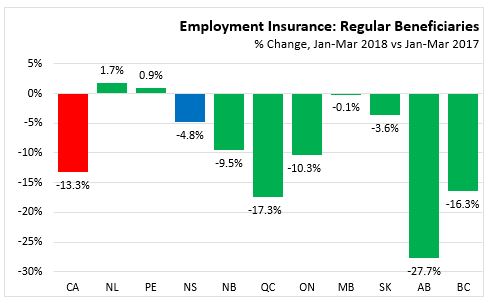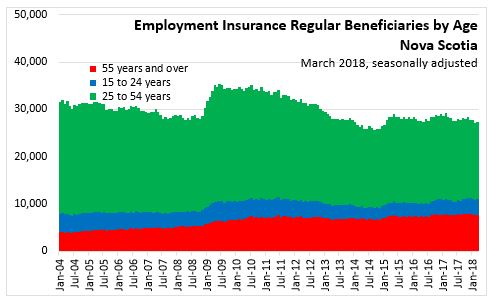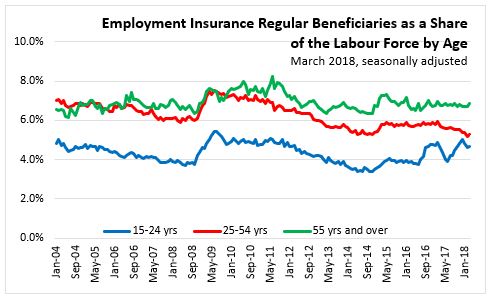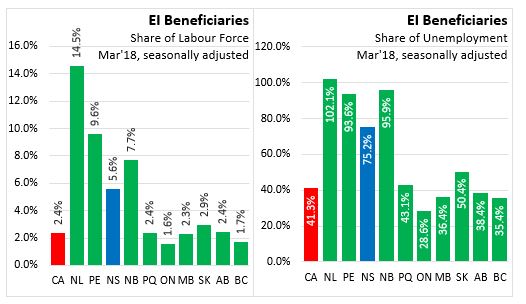The Economics and Statistics Division maintains archives of previous publications for accountability purposes, but makes no updates to keep these documents current with the latest data revisions from Statistics Canada. As a result, information in older documents may not be accurate. Please exercise caution when referring to older documents. For the latest information and historical data, please contact the individual listed to the right.
<--- Return to Archive
For additional information relating to this article, please contact:
May 24, 2018EMPLOYMENT INSURANCE, MARCH 2018 
In March 2018, the number (seasonally adjusted) of Nova Scotians receiving regular Employment Insurance (EI) benefits increased by 370 (1.4 per cent) from the previous month to 27,390 and decreased by 1,010 persons (-3.6 per cent) from March 2017.

Following an increase through much of 2016, the number of EI beneficiaries in Nova Scotia declined until the middle of 2017 and has been relatively flat since. Looking at the longer-term trends, the number of beneficiaries has been relatively stable since 2015 after reaching historic lows in 2014.
The number (seasonally adjusted) of Canadians receiving regular EI benefits in March 2018 decreased 1.5 per cent (7,250 persons) from the previous month to 471,540. The number of regular EI beneficiaries decreased by 76,720 (-14.0 per cent) from March 2017.
AGE
The bulk of EI beneficiaries in Nova Scotia are aged 25 to 54, who also account for the largest share of the labour force. In the March results, the number of beneficiaries aged 25-54 was up 240 while the number of beneficiaries aged 55 and older was up by 110 persons month to month. The number of beneficiaries aged 15-24 was up 30 persons compared to the previous month.

Measured as a share of the labour force, EI usage is more prevalent among older workers (6.9 per cent) than it is among youth (4.7 per cent) or core aged workers (5.3 per cent).

EI BENEFICIARIES AS A SHARE OF THE UNEMPLOYED BY PROVINCE
The number (seasonally adjusted) of Nova Scotians receiving regular EI benefits in March 2018 accounted for 5.6 per cent of the total labour force. In Canada, the number of EI beneficiaries accounted for 2.4 per cent of the total labour force.
In Nova Scotia, EI beneficiaries accounted for 75.2 per cent of the unemployed, compared to a Canadian rate of 41.3 per cent. Across the country, EI beneficiaries accounted for the highest shares of the unemployed in the Atlantic provinces, led by Newfoundland and Labrador. EI beneficiaries accounted for the lowest shares of the unemployed in Ontario, followed by BC and Manitoba.
Note that due to differences in estimation methodology, it is possible for the reported number of EI beneficiaries to exceed the reported number of unemployed in a given jurisdiction.

COUNTIES
In year to date terms (January-March 2018 compared to the same period a year ago), average EI usage (all types of beneficiaries, unadjusted) was up in two counties. Decreases were seen in all counties except Cape Breton and Victoria. The largest decline in percentage terms was in Cumberland (-12.3%).

OCCUPATION
Nova Scotia's EI usage by occupation (unadjusted) is highest among trades/transport/equipment operators (8,700 this month), followed by sales and service occupations, natural resources, and manufacturing occupations. Year over year usage is up for health, and for art, culture, recreation and sport, when comparing March 2018 to a year earlier.
In year to date terms, usage is up (in percentage terms) in Health occupations, and in art, culture recreation and sport occupations as well as unclassified occupations.

Legislative changes to the EI program came into effect in July 2016. While some of these changes affected all EI regions across Canada, eligible claimants in the 15 regions that posted notable increases in unemployment received additional weeks of regular benefits starting in July. More information on the 2016 EI changes is available on Employment and Social Development Canada's (ESDC) website. As a result of the changes to the EI program, historical comparisons are not recommended, except in areas outside of the 15 EI regions where eligible claimants received additional weeks of benefits. These 15 EI regions are Newfoundland and Labrador, Northern Ontario, Sudbury, Northern Manitoba, Southern Saskatchewan, Northern Saskatchewan, Saskatoon, Southern Alberta, Northern Alberta, Calgary, Edmonton, Southern Interior British Columbia, Northern British Columbia, Whitehorse and Nunavut.
Statistics Canada CANSIM 276-0022 (Age, Province), 276-0043 (Occupation), 276-0035 (County level)
<--- Return to Archive